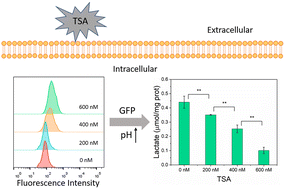A dynamic fluorescence probed glycolysis suppression process in HeLa cells treated with trichostatin A†
Abstract
Acetylation can be regulated by histone deacetylases (HDACs) and histone acetyltransferases (HATs), and the imbalance between HDACs and HATs can lead to cancers. Trichostatin A (TSA), as one of the typical HDAC inhibitors (HDACis), may regulate the acetylation level and thus prevent the proliferation of cancer cells, in which the metabolic change of glycolysis is involved. However, the dynamic process of glycolysis has not yet been explored, and the mechanism is still elusive. In this work, we constructed GFP-actin-HeLa cells to observe the dynamic change of glycolysis in situ and found that the GFP fluorescence enhanced significantly after TSA treatment, which was consistent with the change of pH in the cells (pHi) depending on the change of lactate originated from glycolysis. Furthermore, we confirmed that the glycolysis was inhibited after TSA treatment, and this process was associated with HIF-1α and c-Myc regulation. As such, this work not only demonstrates the usefulness of the GFP fluorescent probe for monitoring the metabolic process of glycolysis in situ, but also sheds new light on the mechanism of glycolysis suppression in the cancer cells treated with HDACi.



 Please wait while we load your content...
Please wait while we load your content...